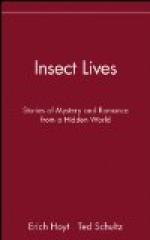In agreement with this manner of life, the cuticle is roughly granulated, often greenish or reddish in hue, and the maggot, despite its want of definite head and sense organs, moves actively and purposefully about, often rearing up on its broad tail-end with an aphid victim impaled on its mouth-hooks.
In a previous chapter reference was made to the exopterygote insects, stone-flies, dragon-flies, and may-flies, whose preparatory stages live in the water. Among the endopterygote orders many Neuroptera and Coleoptera, all Trichoptera, a very few Lepidoptera and many Diptera, have aquatic larvae. One or two examples of the adaptations of dipteran larvae to life in the water may well bring the present chapter to a close. Many members of the hover-fly family (Syrphidae) have maggots with the tail-spiracles situated at the end of a prominent tubular process. Among the best-known of syrphid flies are the drone-flies (Eristalis), often seen hovering over flowers, and presenting a curious likeness to hairy bees. The larva of Eristalis is one of the most remarkable in the whole order, the ‘Rat-tailed maggot’ found in the stagnant water of ditches and pools. It has a cylindrical body with the hinder end drawn out into a long telescopic tube, a more slender terminal section being capable of withdrawal into, or protrusion from, a thicker basal portion. At the extremity of the slender tube is a crown of sharp processes, forming a stellate guard to the spiracles. These processes can pierce the surface-film of the water, and place the tracheal system of the maggot in touch with the pure upper air; while its mouth may be far down, feeding among the foul refuse of the ditch, it can still reach out to the medium in which the end of its life-story must be wrought out.
Reverting to the first great division of the Diptera, we find varied adaptations to aquatic life among many grubs that possess a definite head. The larva of a Gnat (Culex[9]) has projecting from the hind region of the abdomen a long tubular outgrowth, at the end of which are the spiracles, guarded by three pointed flaps forming a valve. When closed these pierce the surface-film of the water in which the larva lives; when opened a little cup-like depression is formed in the surface-film, from which the larva hangs. Or having accumulated a supply of air, it can disengage itself from the surface-film and dive through the water, its tracheal system safely closed. Another mode of breathing is found in the ‘Blood-worms’ and allied larvae of the Harlequin-midges (Chironomidae) whose transformations are described in detail by Miall and Hammond (1900). These larvae have two pairs of cylindrical, spine-bearing pro-legs—one on the prothorax and the other on the hindmost abdominal segment; the latter structures serve to fix the larva in the muddy tube which it inhabits at the bottom of its native pond. The penultimate abdominal segment has four long hollow outgrowths, which contain blood, and have the function of gills, while the hindmost segment has four shorter outgrowths of the same nature. Enabled thus to breathe dissolved air, the Chironomus larva needs not, like the Culex or the Eristalis, to find contact with the atmosphere beyond the surface-film.




